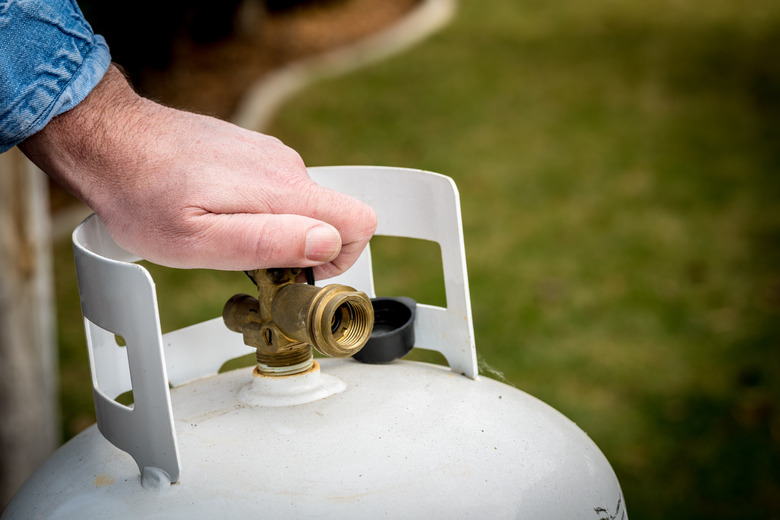What Is A Combustion Reaction?
A combustion reaction, sometimes abbreviated RXN, is any reaction in which a combustible material combines with oxygen or is oxidized. The most common combustion reaction is a fire, in which hydrocarbons burn in air to produce carbon dioxide, water vapor, heat, light and often ashes. While other chemical reactions may produce heat, combustion reactions always share specific characteristics that must be present for a reaction to be a true combustion reaction.
TL;DR (Too Long; Didn't Read)
A combustion reaction is a chemical reaction in which a material combines with oxygen to give off light and heat. In the most common combustion reactions, hydrocarbon-containing materials such as wood, gasoline or propane, burn in air to release carbon dioxide and water vapor. Other combustion reactions, such as the burning of magnesium to produce magnesium oxide, always use up oxygen but don't necessarily produce carbon dioxide or water vapor.
How Combustion Takes Place
How Combustion Takes Place
For a combustion reaction to proceed, combustible materials and oxygen must be present as well as an external energy source to start the combustion. While some material will spontaneously burst into flame when brought together with oxygen gas, most substances need a spark or other source of energy to start burning. Once the combustion reaction starts, the heat generated by the reaction is enough to keep it going.
For example, when you start a wood fire, the hydrocarbons in the wood combine with oxygen in the air to form carbon dioxide and water vapor, releasing energy in the form of heat and light. To start the fire, you need an external energy source such as a match. This energy breaks the existing chemical bonds so that the carbon, hydrogen and oxygen atoms can react.
The combustion reaction releases much more energy than is needed to break the chemical bonds. As a result, the wood continues to burn until the hydrocarbons are used up. Any nonhydrocarbon impurities in the wood are deposited as ashes. Wet wood does not burn well because turning the water in the wet wood to steam uses up energy. If all the energy produced by the combustion reaction is used for vaporizing the water in the wood, none is left to keep the reaction going, and the fire goes out.
Examples of Combustion Reactions
Examples of Combustion Reactions
The combustion of methane, the main component of natural gas, is an example of a typical combustion reaction. Stoves and furnaces running on natural gas have a pilot light or spark to provide the external energy necessary for starting the combustion reaction.
The methane has chemical formula CH4, and it burns with oxygen molecules from the air, chemical formula O2. When the two gases come into contact, combustion does not start because the molecules are stable. Within a spark or pilot light, the single oxygen bond and the four methane bonds are broken, and the individual atoms react to form new bonds.
Two oxygen atoms react with the carbon atom to form a molecule of carbon dioxide, and two more oxygen atoms react with the four hydrogen atoms to form two molecules of water. The chemical formula is CH4 + 2O2 = CO2 + 2H2O. The formation of the new molecules releases a substantial amount of energy in the form of heat and light.
The combustion of magnesium does not release carbon dioxide or water vapor, but it is still a combustion reaction because it is an exothermic reaction of a combustible material with oxygen. Placing magnesium in the air is not enough to start combustion, but a spark or flame breaks the bonds of the oxygen molecules in the air to allow the reaction to proceed.
The magnesium combines with oxygen from the air to form magnesium oxide and excess energy. The chemical formula for the reaction is O2 + 2Mg = 2MgO, and the excess energy is released in the form of intense heat and bright, white light. This example shows that a chemical reaction may be a combustion reaction without having the characteristics of a traditional fire.
References
Cite This Article
MLA
Markgraf, Bert. "What Is A Combustion Reaction?" sciencing.com, https://www.sciencing.com/what-is-a-combustion-reaction-13712162/. 24 April 2018.
APA
Markgraf, Bert. (2018, April 24). What Is A Combustion Reaction?. sciencing.com. Retrieved from https://www.sciencing.com/what-is-a-combustion-reaction-13712162/
Chicago
Markgraf, Bert. What Is A Combustion Reaction? last modified August 30, 2022. https://www.sciencing.com/what-is-a-combustion-reaction-13712162/
